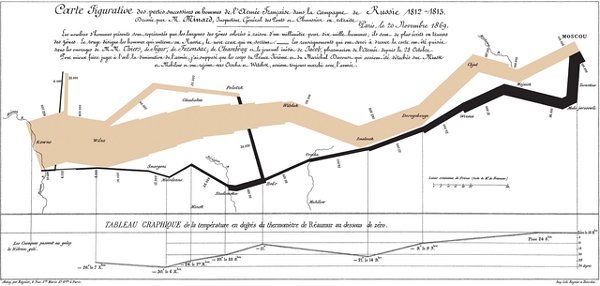
This chart, devised in 1869 by French civil engineer Charles Minard, illustrates the disastrous toll suffered by Napoleon’s army on its foray into Russia in 1812. Yale political scientist Edward Tufte describes it in his 1983 book The Visual Dislay of Quantitative Information:
Beginning at the left on the Polish-Russian border near the Niemen River, the thick band shows the size of the army (422,000 men) as it invaded Russia in June 1812. The width of the band indicates the size of the army at each place on the map. In September, the army reached Moscow, which was by then sacked and deserted, with 100,00 men. The path of Napoleon’s retreat from Moscow is depicted by the darker, lower band, which is linked to a temperature scale and dates at the bottom of the chart. It was a bitterly cold winter, and many froze on the march out of Russia. As the graphic shows, the crossing of the Berezina River was a disaster, and the army finally struggled back into Poland with only 10,000 men remaining. Also shown are the movements of auxiliary troops, as they sought to protect the rear and the flank of the advancing army. Minard’s graphic tells a rich, coherent story with its multivariate data, far more enlightening that just a single number bouncing along over time. Six variable are plotted: the size of the army, its location on a two-dimensional surface, direction of the army’s movement, and temperature on various dates during the retreat from Moscow.
He concludes, “It may well be the best statistical graphic ever drawn.”
